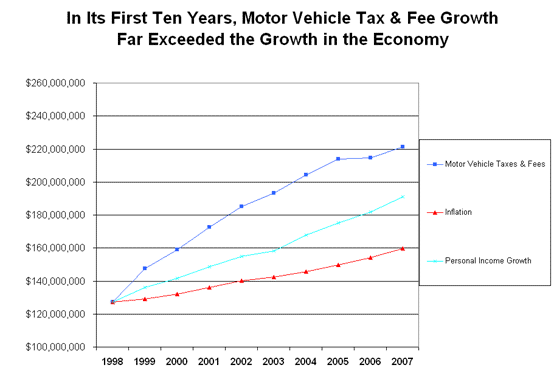
Taxes in Nebraska > Sources of Major State and Local Taxes > Motor Vehicle Taxes and Fees
MOTOR VEHICLE TAXES AND FEES
| Overview The motor vehicle tax and motor vehicle fee replaced the property tax levied on motor vehicles beginning Jan. 1, 1998. Under the pre-1998 system, motor vehicles were assigned a value by the Tax Commissioner based on average sales price for vehicles of that make, age, and model, and the local property taxing units of government merely assessed the rate against that value. Property taxes were paid by the owner at registration based on the rate assessed for the previous property tax year. Under the current system, the motor vehicle tax and fee are still paid at the time of registration. However, the tax paid is now uniform throughout the state and only three types of local governments share in the proceeds. The motor vehicle tax phases out once a vehicle reaches 14 years of age, but the motor vehicle fee is levied throughout the life of the vehicle. The tax on any particular motor vehicle is the result calculated by multiplying the base rate of tax times a factor that declines with age. The base rate is based on manufacturer's suggested retail price in the case of passenger cars, motorcycles, pickups, vans and SUVs and the manufacturer's rated weight for commercial vehicles. Exemptions from the tax are the same as was the case under the property tax system. These are primarily government vehicles and those used for, religious, educational, and charitable purposes. The motor vehicle tax is distributed to the city, county, and school system where the vehicle is registered. The school receives 60% of the proceeds with the municipality and county dividing the rest. If the motor vehicle is not registered within any municipality, the county receives both shares. The motor vehicle fee is divided equally between municipalities and counties based on the formula used for distributing motor fuel taxes and other taxes that contribute to the Highway Trust Fund. This information, including the tax and fee schedules is spelled out in detail in the "Program History and Description". Tax Policy and the Motor Vehicle Tax and Fee Adequacy - While our experience with the motor vehicle tax and fee system is limited, the tax appears to be stable and fast-growing. Personal and business motor vehicles are largely a necessity in a modern society so we could expect the proceeds from the tax to vary little with the condition of the economy. The proceeds of the tax also seem to grow faster that the economy itself as shown in the analysis below. This is likely for the same reasons that sales tax on motor vehicles has grown so rapidly, an increase in the number of vehicles and/or an increase in average prices of motor vehicles. Equity - The motor vehicle fee imposes a tax that decreases only slightly with the cost of a passenger vehicle and its age. The motor vehicle tax on the other hand is based on a progressive schedule that charges an increasing percentage tax burden as the value of a new passenger vehicle increases. This is because the first bracket is fairly wide ($0 - $3,999) and has only a $25 tax when new. This is less than 1% of the value of the motor vehicle. Subsequent brackets increase the tax $10 to $40 for each $2,000 of value when new, or two percent. The higher the value of the passenger vehicle, the smaller the share of the vehicle that is taxed at the lowest, first-bracket rate. This progressivity mitigates the regressive impact of the motor vehicle fee. There is also some correlation between the taxes and fees paid and benefits received from the government levying the tax. The motor vehicle fee flows entirely to municipalities and counties which must spend the money on streets and roads. Forty percent of the motor vehicle tax also goes to municipalities and counties. Simplicity - The motor vehicle tax and fee system is relatively easy to administer. It is collected at the time of registration, along with other taxes and fees. It is based on a uniform schedule available to all counties. These features keep the cost of collection low. Accountability - As mentioned previously, the fee flows entirely to municipalities and counties as does 40% of the tax. These are the entities primarily responsible for local streets, roads and bridges. However, 60% of the tax goes to schools where this accountability connection is not present. Economic competitiveness - When the motor vehicle tax and fee system replaced property taxes on motor vehicles, the tax obligation was made identical in every location in the state. This made the tax much more economically neutral.
NOTE: The 2007 number is an estimate. In its 10 years of existence, motor vehicle taxes and fees combined have grown faster than inflation and the Nebraska economy. This is despite the fact that there have been no changes in rate or base during this time. While this may not be enough time to establish a long-term trend, there are a couple of factors that suggest that this observation may be true over the long-run. As shown in the sales tax analysis in this presentation, sales tax on motor vehicles also has grown faster than the economy and faster than any other segment of the sales tax. As was observed there, this rapid growth has flattened out the past two years. We speculated there that this phenomenon may be due to new and used car price growth exceeding inflation growth. Regardless of the cause, it is a long-term trend and supports the notion that the same may be true with regard to the motor vehicle tax. Second, the motor vehicle tax has a progressive rate schedule, which means that price inflation has an even greater effect on tax receipts due to bracket creep. |
